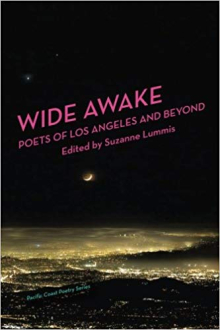
In her introduction to Wide Awake, editor Suzanne Lummis informs us how she and her publisher came up with the title for this poetry anthology. They wanted a title that “stands against the notion that the metropolis is densely packed with dreamers who came to participate in The Dream Factory but will be disappointed (de-deluded), and wind up drifting down the Boulevard of Broken Dreams.” Lummis is pointing at the reputation of Los Angeles as a city that breathes for dreamers who are drawn to the glitter, fame, and the notion of success in Hollywood that only few can attain. In many ways, the image on the book’s cover appears to come from a dreamer’s perspective. It’s a snapshot of Los Angeles at night, taken from Mt. Wilson by astrophotographer Dave Jurasevich, looking at the city from a far distance, up there on the hills, looking at thousands of lights, levitating in dreams, far removed from “the sharper elements of the world.”
This wonderful 'dreamy' image offers an exciting contrast to the idea of being ‘wide awake,' in the context of this anthology. One might argue that dreaming and being wide awake are the twin souls of poetry. The language of poetry needs the dimension of wakefulness, to capture the “sharper elements of the world.” Poets often work with concrete objects and things, such as cars, buildings, plants, or people walking, and filter them through poetic devices to invoke perceptions and visions in the poet’s mind, in order to evoke a range of emotions and insights akin to things like love, sadness, God, or a city of dreams. Through these devices, poets make language dream, levitate, or create prophecies about their environment. Indeed, this anthology offers a wide array of poetic visions about Los Angeles.
Liz Gonzalez’s “Confessions of a Pseudo-Chicana” made me think about Los Angelenos who oscillate between cultures to feel rooted and, to an extent, authentic. The persona of Gonzalez’ “pseudo-Chicana” paints an internal struggle about being Mexican-American, or, more specifically, being Chicana; she feels guilty that “[m]ost of [her] friends who carry green cards / flew in from the blue-eyed countries.” She’s telling us about her public life, that somehow she doesn’t feel like an outsider with her blue-eyed friends. But for Iranian-American Sholeh Wolpè, feelings of exclusion are part of the air she breathes, that she will always be “alien, immigrant, Iranee,” even though she is “now an American / with an American husband / and American children.” She succumbs to the idea of being eternally foreign in America: “I do not belong anywhere. / I have an accent in every language I speak.”
In Melissa Roxas’ “Geography Lesson,” we hear a survivor of torture from another country: “I can show you / the maps / on my body // bruises / the torturers left / these scattered brown things / in a mouth / thick with layers of tongue.” “[L]ayers of tongue” is a beautiful phrase, multidimensional, which, for me, includes the language of trauma and resistance, psychic screams that will last a lifetime, embedded in the language of hope. Then we hear another dimension of torture in Laurel Ann Bogen’s “The Door for Love and Death”: “ In the room of Exquisite Torture, / A woman watches her lover shave.” How, indeed, can torture be exquisite? Bogen takes us to the realm of the erotic, where an array of fetishes awakens the instincts of voyeurism.
Our city’s poet laureate from 2021 to 2022, Lynne Thompson, offers four poems in the anthology. She writes about the implosive reckonings of desire with “lips the color of peril,” cruising Highway 134, looping “the River Los Angeles with its confessions buried in concrete under a stubborn scent of smog.” The L.A. River became a concrete channel, to control frequent severe flooding in the early part of the 20th century. But Thompson gives the river a dimension of death, making the river a kind of massive, winding tombstone of secrets and stories we can only imagine or re-imagine through poetry and fiction. In a way, she’s stepping into noir territory, a genre in film and fiction very much rooted in our city’s film industry. In fact, there’s a poem in the collection that illuminates the definition of ‘noir’ with gothic verve and panache, quite succinctly. In “It’s Noir,” Cece Peri tells us that it’s noir:
if the dead
are buying land
out in the valley
if there’s a car
a cliff
and a claims adjuster
if a wife buys a black veil
before she needs
a black veil
These days, we probably live in the imagination of noir to the nth power. The massive consequences of COVID are felt by everyone, like an endless nightmare without the redeeming distraction of waking, playing a domino effect of destruction, death, and mourning. Some of us turned to prayer, meditations, and no doubt, poetry, as well. Through this anthology, it’s possible to feel the city’s poetic visions a few moments before lockdown’s stealthy effects on our lives. Indeed, Beyond Baroque Book’s coverage of poetic voices in this anthology is sweeping, stunning, and urgent in its diversity. No doubt countless muses are waiting to channel their music and prophecies to poets for a future version of Wide Awake, to underline a new era of wakefulness and wokeness, in the City of Angels, around it, and beyond.
And read an interview with Suzanne Lummis.